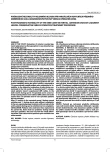SELECTIVE EMBOLIZATION OF ARTERIAL BLEEDING IN INJURIES OF THE ACETABULUM – A CASE REPORT
Authors:
Jakub Avenarius 1; Filip Cihlář 2; Petr Obruba 1; Karel Edelmann 1
Authors‘ workplace:
Klinika úrazové chirurgie UJEP, Úrazové centrum, Krajská zdravotní, a. s., Masarykova nemocnice v Ústí nad Labem, o. z.
UJEP The Department of Trauma Surgery, Trauma Center, Regional Health, Inc., Masaryk Hospital in Usti nad Labem
1; Radiodiagnostické oddělení, Krajská zdravotní, a. s., Masarykova nemocnice v Ústí nad Labem, o. z.
Department of Radiology, Regional Health, Inc., Masaryk Hospital in Usti nad Labem
2
Published in:
Úraz chir. 24., 2016, č.2
Overview
Introduction:
The authors report a case of a 65-year old man who suffered right acetabular fracture with bleeding from a superior gluteal artery branch after fall from bicycle. Bleeding was diagnosed with CT-angiography done because of circulatory instability. Selective embolization was used to stop bleeding because of complicated surgical access to the bleeding artery. Embolization is the method of choice to stop bleeding from the superior gluteal artery since it is minimally invasive with high success rate.
Conclusion:
Unlike fractures of the sacrum, dangerous bleeding is relatively rarely associated with fractures oft he acetabulum, yet we still need to keep it in mind if hemodynamic instability of the patient is present.
Key words:
Acetabular fracture, angiography, selective embolization.
Sources
1. CIHLÁŘ, F., MIŠIČKO, R., KRAJINA, A. et al. Multidetektorová výpočetní tomografie u traumat – vliv lokalizace, velikosti a denzity aktivního krvácení na volbu následné terapie. Ces Radiol. 2014, 68, 129–136.
2. IERARDI, AM., PIACENTINO, F., FONTANA, F. et al. The role of endovascular treatment of pelvic fracture bleeding in emergency settings. Eur Radiol. 2015, 25, 1854–1864.
3. KATTHAGEN, BD., SPIES, H., BACHMANN, G. Arterial vascularization of the bony acetabulum. Orthop Ihre Grenzgeb. 1995, 133, 7–13.
4. KARADIMAS, EJ., NICOLSON, T., KAKAGIA, DD. et al. Angiographic embolisation of pelvic ring injuries. Treatment algorithm and review of the literature. Int Orthop. 2011, 35, 1381–1390.
5. KHANNA, P., PHAN, H., HAL HARDY, A. et al Multidisciplinary Management of Blunt Pelvic Trauma. Semin Intervent Radiol. 2012, 29, 187–191.
6. PIERI, S., AGRESTI, P., MORUCCI, M. et al Percutaneous management of hemorrhages in pelvic fractures. La Radiologia Medica. 2004, 107, 241–251.
7. TÖTTERMAN, A., DORMAGEN, JB., MADSEN, JE. et al. A protocol for angiographic embolization in exsanguinating pelvic trauma. Acta Orthop. 2006, 77, 462–468.
8. TÖTTERMAN, A., MADSEN, JE., SKAGA, NO. et al Extraperitoneal pelvic packing: a salvage procedure to control massive traumatic pelvic he-morrhage. J Trauma. 2007, 62, 843–852.
Labels
Surgery Traumatology Trauma surgeryArticle was published in
Trauma Surgery

2016 Issue 2
- Metamizole at a Glance and in Practice – Effective Non-Opioid Analgesic for All Ages
- Metamizole in perioperative treatment in children under 14 years – results of a questionnaire survey from practice
- Possibilities of Using Metamizole in the Treatment of Acute Primary Headaches
- Safety and Tolerance of Metamizole in Postoperative Analgesia in Children
- Obstacle Called Vasospasm: Which Solution Is Most Effective in Microsurgery and How to Pharmacologically Assist It?
Most read in this issue
- PRINCIPLES OF INDICATION OF INTRA-ARTICULAR DISTAL RADIUS FRACTURES FOR CONSERVATIVE OR SURGICAL TREATMENT USING LOCKING PLATES
- SELECTIVE EMBOLIZATION OF ARTERIAL BLEEDING IN INJURIES OF THE ACETABULUM – A CASE REPORT
- DIAGNOSTIC AND TREATMENT OPTIONS OF BLUNT ABDOMINAL TRAUMA IN A REGIONAL HOSPITAL
